Effects of Nanocrystal Cellulose from Bamboo on the Flexural Strength of Acrylic Resin: In Vitro
Abstract
1. Introduction
2. Materials and Methods
2.1. Bamboo NCC Preparations
- Pre-treatment of bamboo fibers
- NCC extraction
2.2. Workpiece Preparation
2.3. Three-Point Flexural Strength Test
2.4. Statistical Analysis
3. Results
3.1. Fractural Strength of NCC-Reinforced Acrylic Resin
3.2. SEM of NCC-Reinforced Acrylic Resin
4. Discussion
5. Conclusions
Author Contributions
Funding
Institutional Review Board Statement
Informed Consent Statement
Data Availability Statement
Conflicts of Interest
References
- Sakaguchi, R.L.; Powers, J.M. Craig’s Restorative Dental Materials, 13th ed.; Elsevier: Mosby, MO, USA, 2012; pp. 63–70. [Google Scholar]
- Anusavice, K.J.; Shen, C.; Rawls, H.R. Phillips’ Science of Dental Materials, 12th ed.; Elsevier Health Sciences: St. Louis, MO, USA, 2013; pp. 495–496. [Google Scholar]
- Patel, M.B.; Bencharit, S. A treatment protocol for restoring occlusal vertical dimension using an overlay removable partial denture as an alternative to extensive fixed restorations: A clinical report. Open Dent. J. 2009, 3, 213–218. [Google Scholar] [CrossRef] [PubMed]
- Thwe, M.M.; Liao, K. Effect of environmental aging on the mechanical properties of bamboo-glass fiber reinforced polymer matrix hybrid composites. Compos. Part A Appl. Sci. Manuf. 2002, 33, 43–52. [Google Scholar] [CrossRef]
- Zbigniew, R.; Danuta, N. Mechanical properties of hot curing acrylic resin after reinforced with different kinds of fibers. Int. J. Biomed. Mater. Res. 2013, 1, 9–13. [Google Scholar]
- El Sheikh, A.M.; Al Zahrani, S.B. Causes of denture fracture: A survey. Saudi Dent. J. 2006, 18, 149–154. [Google Scholar]
- Siqueira, G.; Bras, J.; Dufresne, A. Cellulosic bionanocomposites: A review of preparation, properties and applications. Polymers 2010, 2, 728–765. [Google Scholar] [CrossRef]
- Boufi, S.; Kaddami, H.; Dufresne, A. Mechanical performance and transparency of nanocellulose reinforced polymer nanocomposites. Macromol. Mater. Eng. 2014, 299, 560–568. [Google Scholar] [CrossRef]
- Sugiman, S.; Setyawan, P.D.; Maryudi, M.; Madnasri, S. Water absorption, tensile, flexural and impact properties of aged bamboo fibre/nano CaCO3-modified unsaturated polyester composites. Tamkang J. Sci. Eng. 2020, 24, 239–251. [Google Scholar]
- Phanthong, P.; Reubroycharoen, P.; Hao, X.; Xu, G.; Abudula, A.; Guan, G. Nanocellulose: Extraction and application. Carbon Resour. Convers. 2018, 1, 32–43. [Google Scholar] [CrossRef]
- Liu, D.; Song, J.; Anderson, D.P.; Chang, P.R.; Hua, Y. Bamboo fiber and its reinforced composites: Structure and properties. Cellulose 2012, 19, 1449–1480. [Google Scholar] [CrossRef]
- Senthilkumar, K.; Saba, N.; Rajini, N.; Chandrasekar, M.; Jawaid, M.; Siengchin, S.; Alotman, O.Y. Mechanical properties evaluation of sisal fibre reinforced polymer composites: A review. Constr. Build Mater. 2018, 174, 713–729. [Google Scholar] [CrossRef]
- Arib, R.M.N.; Sapuan, S.M.; Ahmad, M.M.H.M.; Paridah, M.T.; Khairul Zaman, H.M.D. Mechanical properties of pineapple leaf fibre reinforced polypropylene composites. Mater. Des. 2006, 27, 391–396. [Google Scholar] [CrossRef]
- Salih, S.I.; Oleiwi, J.K.; Hamad, L.Q.A. Numerically and theoretically studying of the upper composite complete prosthetic denture. Eng. Technol. J. 2015, 33, 1023–1037. [Google Scholar]
- Klemm, D.; Kramer, F.; Moritz, S.; Lindström, T.; Ankerfors, M.; Gray, D.; Dorris, A. Nanocelluloses: A New Family of Nature-Based Materials. Angew. Chem. Int. Ed. 2011, 50, 5438–5466. [Google Scholar] [CrossRef]
- Oleiwi, J.K.; Hamad, Q.A.; Abdul Rahman, H.J. Studying the effect of natural bamboo and rice husk powders on compressive strength and hardness of acrylic resin. Iraqi J. Mech. Mater. Eng. 2019, 19, 105–113. [Google Scholar] [CrossRef][Green Version]
- Oleiwi, J.K.; Salih, S.I.; Fadhil, H.S. Effect of Siwak and Bamboo Fibers on Tensile Properties of Self-Cure Acrylic Resin Used for Denture Applications. J. Mater. Sci. Eng. 2017, 6, 370. [Google Scholar] [CrossRef]
- Habibi, Y.; Lucia, L.A.; Rojas, O.J. Cellulose Nanocrystals: Chemistry, Self-Assembly, and Applications. Chem. Rev. 2010, 110, 3479–3500. [Google Scholar] [CrossRef]
- Abdul Khalilab, H.; Davoudpour, Y.; Islam, M.N.; Mustapha, A.; Sudesh, K.; Dungani, R.; Jawaid, M. Production and modification of nanofibrillated cellulose using various mechanical processes: A review. Carbohydr. Polym. 2014, 99, 649–665. [Google Scholar] [CrossRef] [PubMed]
- Ning, L.; Yang, B. Characteristics of bamboo fiber and its application. J. Therm. Sci. Technol. 2007, 3, 15–17. [Google Scholar]
- Dransfield, S.; Widjaja, E. Plant Resources of South-East Asia; Pudoc Scientific Publishers: Wageningen, The Netherlands, 1995. [Google Scholar]
- Yu, M.; Yang, R.; Huang, L.; Cao, X.; Yang, F.; Liu, D. Preparation and characterization of bamboo nanocrystalline cellulose. Bioresources 2012, 7, 1802–1812. [Google Scholar] [CrossRef]
- Reis, J.M.; Vergani, C.E.; Pavarina, A.C.; Giampaolo, E.T.; Macha-do, A.L. Effect of relining, water storage and cyclic loading on the flexural strength of a denture base acrylic resin. J. Dent. 2006, 3, 420–426. [Google Scholar] [CrossRef]
- Anusavice, K.J.; Phillips, R.W. Phillips’ Science of Dental Materials, 11th ed.; WB Saunders: St. Louis, MO, USA, 2003; pp. 83–89. [Google Scholar]
- Salman, A.D.; Jani, G.H.; Fatalla, A.A. Comparative Study of the Effect of Incorporating SiO2 Nano-Particles on Properties of Poly methyl Methacrylate Denture Bases. Biomed. Pharmacol. J. 2017, 10, 1525–1535. [Google Scholar] [CrossRef]
- Yu, W.; Wang, X.; Tang, Q.; Guo, M.; Zhao, J. Reinforcement of denture base PMMA with ZrO2 nanotubes. J. Mech. Behav. Biomed. Mater. 2014, 32, 192–197. [Google Scholar] [CrossRef]
- Topouzi, M.; Kontonasaki, E.; Bikiaris, D.; Papadopoulou, L.; Paraskevopoulos, K.M.; Koidis, P. Reinforcement of a PMMA resin for interim fixed prostheses with silica nanoparticles. J. Mech. Behav. Biomed. Mater. 2017, 69, 213–222. [Google Scholar] [CrossRef] [PubMed]
- Zidan, S.; Silikas, N.; Haider, J.; Alhotan, A.; Jahantigh, J.; Yates, J. Evaluation of Equivalent Flexural Strength for Complete Removable Dentures Made of Zirconia-Impregnated PMMA Nanocomposites. Materials 2020, 13, 2580. [Google Scholar] [CrossRef] [PubMed]
- Stafford, G.D.; Smith, D.C. Flexural fatigue tests of some denture base polymers. Br. Dent. J. 1970, 128, 442–445. [Google Scholar] [CrossRef] [PubMed]
- Vallittu, P.K.; Lassila, V.P.; Lappalainen, R. Transverse strength and fatigue of denture acrylic-glass fiber composite. Dent. Mater. 1994, 10, 116–121. [Google Scholar] [CrossRef]
- Kelly, E. Fatigue failure in denture base polymers. J. Prosthet. Dent. 1969, 21, 257–266. [Google Scholar] [CrossRef]
- Golbidi, F.; Jalali, O. An evaluation of the Flexural Properties of Meliodent and Acropars Heat Polymerized Acrylic Resins. J. Dent. Tehran Univ. Med. Sci. 2007, 4, 68–71. [Google Scholar]
- Ogawa, T.; Hasegawa, A. Effect of curing environment on mechanical properties and polymerizing behaviour of methyl-methacrylate autopolymerizing resin. J. Oral Rehabil. 2005, 32, 221–226. [Google Scholar] [CrossRef]
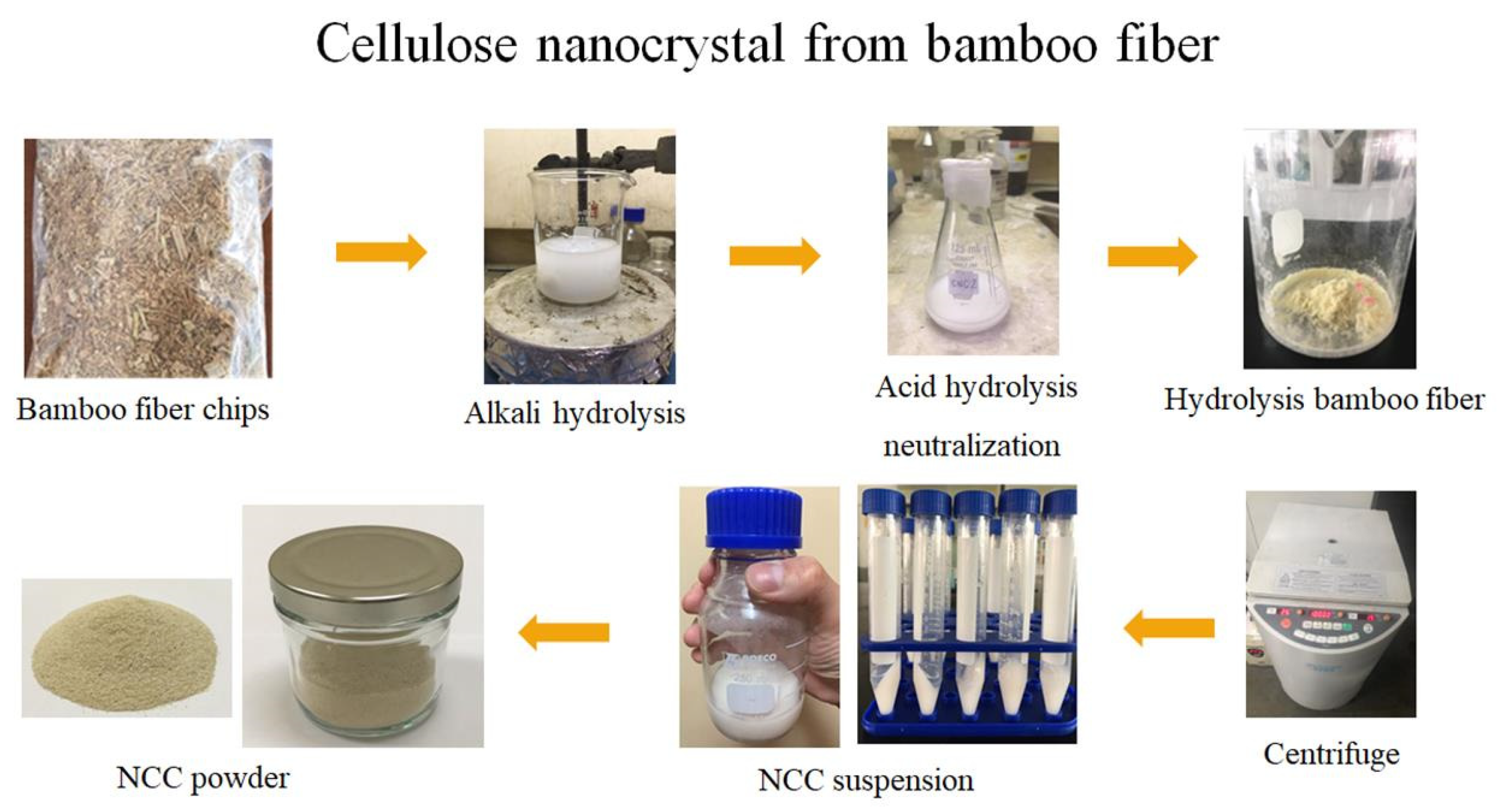
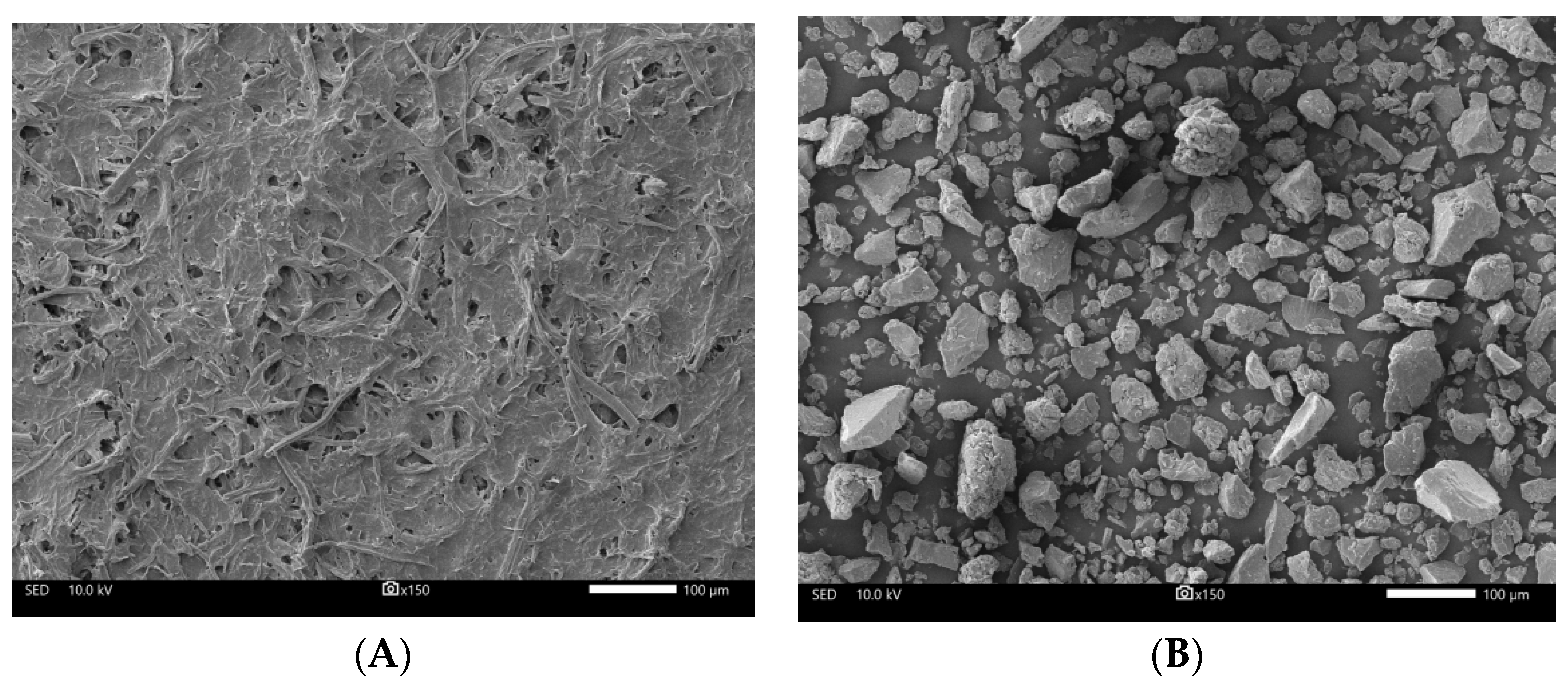

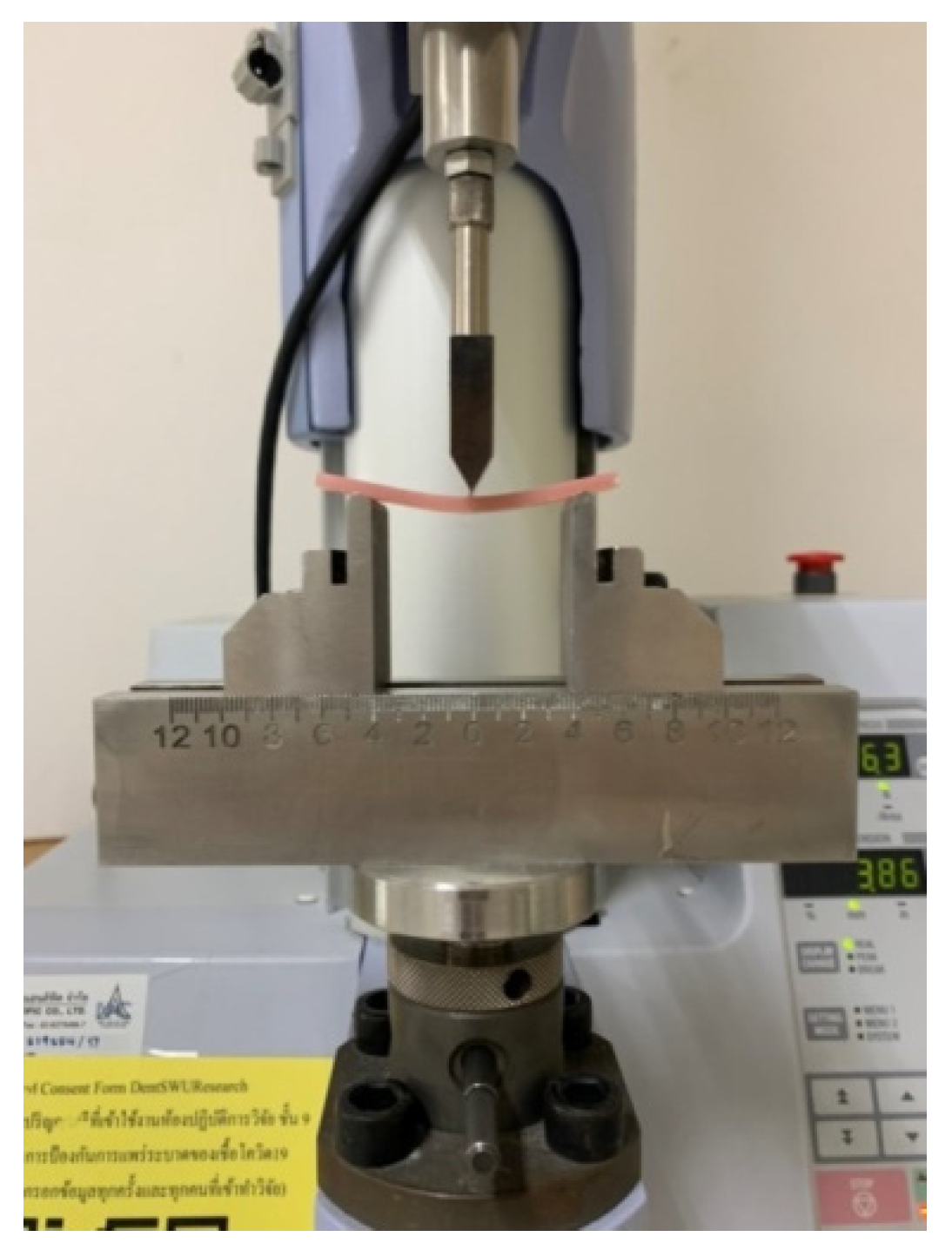
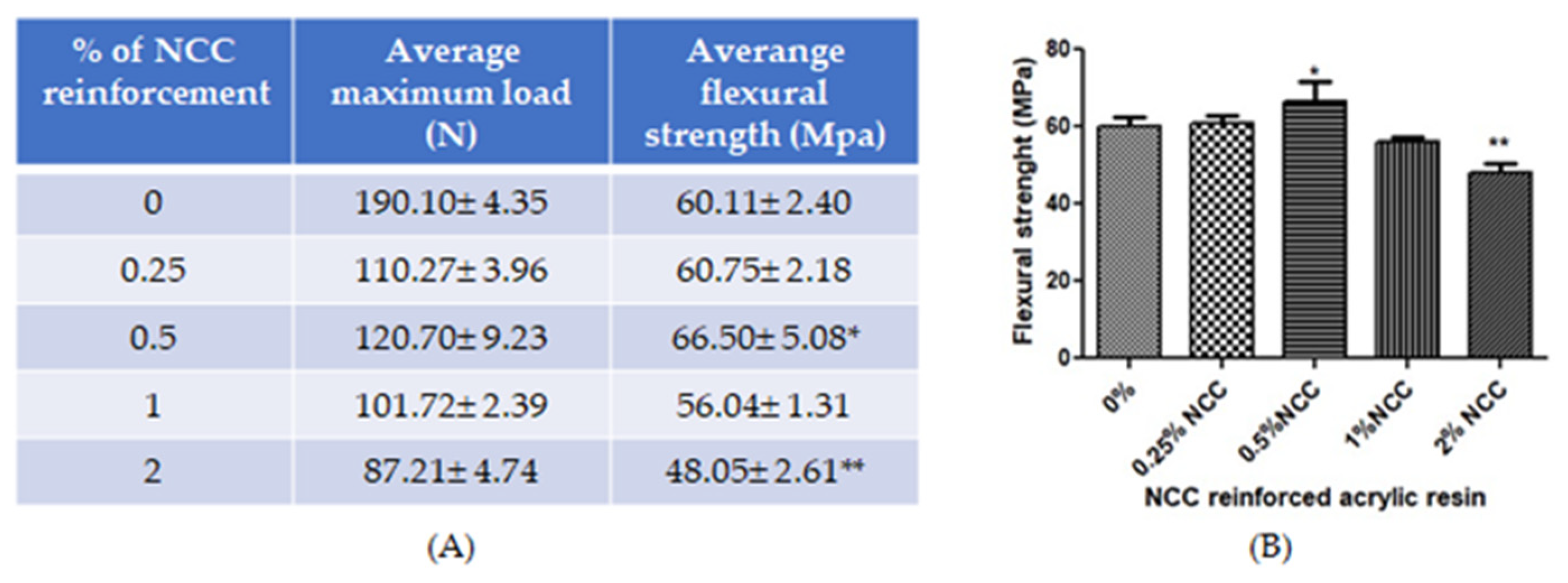
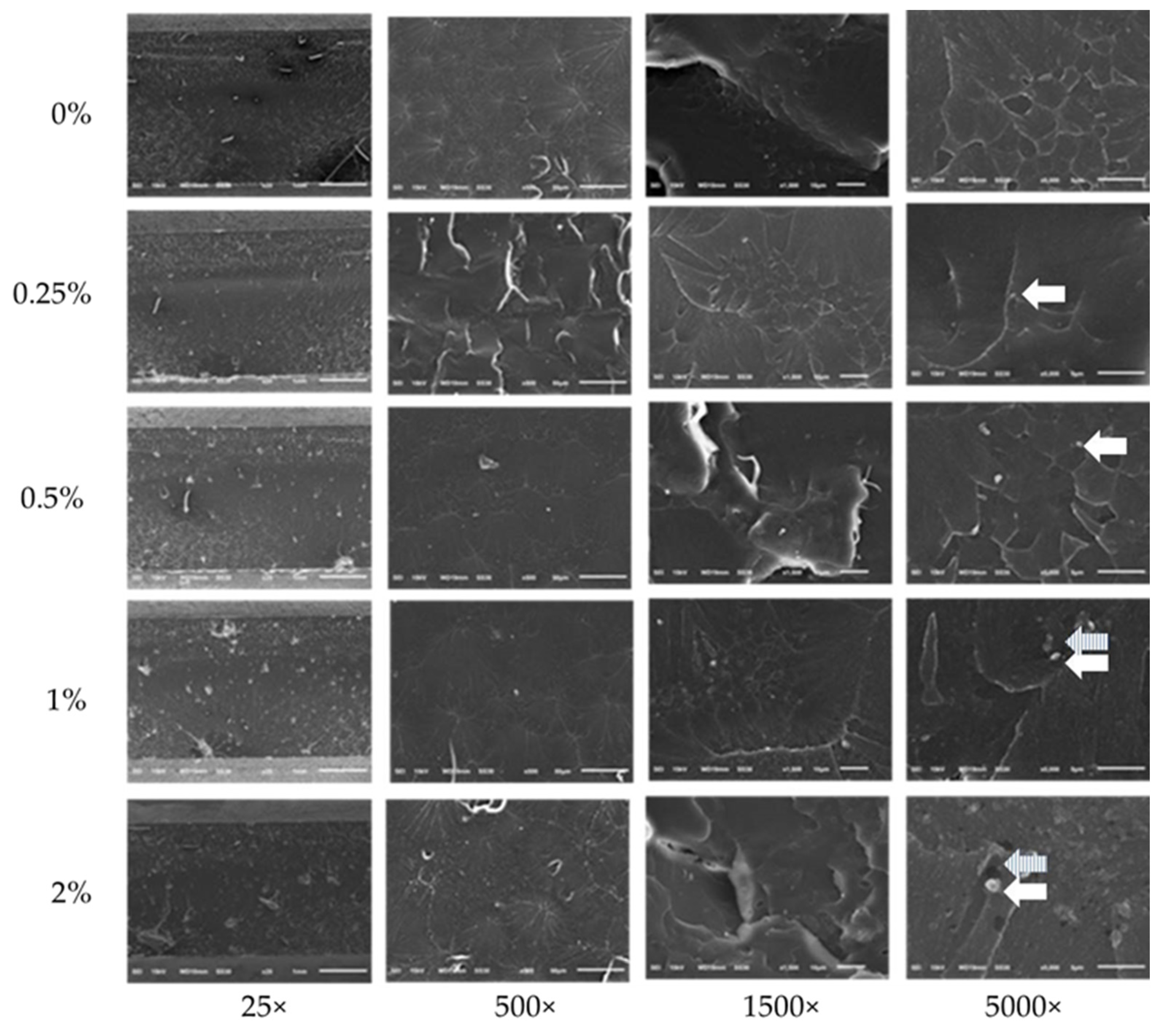
Publisher’s Note: MDPI stays neutral with regard to jurisdictional claims in published maps and institutional affiliations. |
© 2022 by the authors. Licensee MDPI, Basel, Switzerland. This article is an open access article distributed under the terms and conditions of the Creative Commons Attribution (CC BY) license (https://creativecommons.org/licenses/by/4.0/).
Share and Cite
Aupaphong, V.; Kraiwattanawong, K.; Thanathornwong, B. Effects of Nanocrystal Cellulose from Bamboo on the Flexural Strength of Acrylic Resin: In Vitro. Dent. J. 2022, 10, 129. https://doi.org/10.3390/dj10070129
Aupaphong V, Kraiwattanawong K, Thanathornwong B. Effects of Nanocrystal Cellulose from Bamboo on the Flexural Strength of Acrylic Resin: In Vitro. Dentistry Journal. 2022; 10(7):129. https://doi.org/10.3390/dj10070129
Chicago/Turabian StyleAupaphong, Visakha, Kriangsak Kraiwattanawong, and Bhornsawan Thanathornwong. 2022. "Effects of Nanocrystal Cellulose from Bamboo on the Flexural Strength of Acrylic Resin: In Vitro" Dentistry Journal 10, no. 7: 129. https://doi.org/10.3390/dj10070129
APA StyleAupaphong, V., Kraiwattanawong, K., & Thanathornwong, B. (2022). Effects of Nanocrystal Cellulose from Bamboo on the Flexural Strength of Acrylic Resin: In Vitro. Dentistry Journal, 10(7), 129. https://doi.org/10.3390/dj10070129





